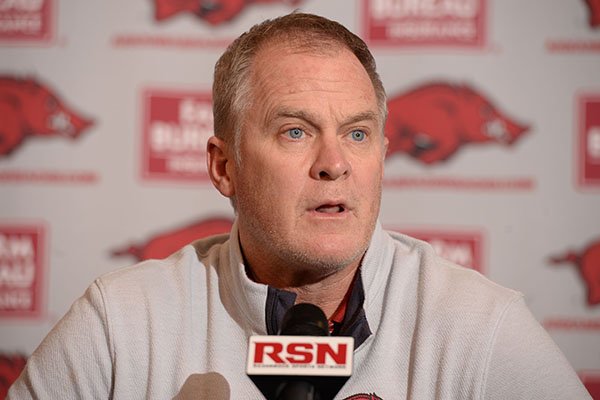FAYETTEVILLE — When the University of Arkansas athletics department assembled its budget during the spring for the 2021 fiscal year, cutting a sport was never considered.
The department’s optimistic budget of $124.5 million does not take into account potential losses in revenue, such as decreased football ticket sales, but it also does little to take away from the day-to-day experience of the Razorbacks’ athletes.
Maintaining that experience — and a team — in all 19 sports was of the utmost importance, UA athletics director Hunter Yurachek said, even during uncertain economic times.
“It would have to get extremely bad for us to cut sports,” Yurachek said. “You look at the financial metrics behind cutting a sport and there’s really not a significant number of savings.
“First you would have to identify: What sport do we cut at the University of Arkansas? And I can’t name one that would make any sense to do that with. And then you look at what’s the financial sake of cutting one sport?
“If you cut any sports you’re going to have an impact on your student-athletes, so we’ve never even had a discussion about cutting any sports.”
Expenses exceeded revenues in 16 sports at Arkansas in fiscal 2019, according to a financial report submitted to the NCAA. Football, men’s basketball and baseball turned profits that year in excess of $44.3 million, which helped cover a combined loss of more than $26 million in the other sports.
Turning a profit in baseball is unique, but otherwise Arkansas’ situation isn’t all that much different than most other high-profile athletics departments. And so far, the elimination of sports has been confined to schools that compete outside the Power 5 conferences - the Atlantic Coast Conference, Big Ten, Big 12, Pac-12 and Southeastern Conference.
Research by The Associated Press late last month identified 19 programs — 15 in men's sports and 4 in women's — had been eliminated at 10 universities that compete in the NCAA’s largest classification, Division I. The AP reported 66 other programs had been cut at the Division II and Division III levels.
One of the 19 programs cut in Division I, Bowling Green’s baseball team has since been reinstated following a $1.5 million fundraising drive. A Furman baseball alumni group has been unsuccessful in similar efforts to fund its program that has been shuttered.
Steve Dittmore, a UA professor of sport management, said he has been interested to see so many cuts to sports with high roster counts and low scholarship numbers, such as baseball with 35 players and 11.7 scholarships.
“The Furman example is one that I just think is really interesting,” Dittmore said. “There are roughly 2,000 or so undergraduates and 400-plus athletes, which means it is a substantial percentage of their campus. It’s much more like a Division III school — like a Hendrix College (in Conway) would be — than a Division I school.
“Those things that affect a university’s bottom line, I think, are the things that are concerning as we look at the landscape of sports that are being cut.”
Dittmore said there are other ways for athletics departments to cut costs, such as reducing travel budgets. Yurachek cited travel expenses earlier this month when he told his coaches the Razorbacks could begin scheduling teams from Arkansas State and Central Arkansas, a practice previously off limits to Arkansas coaches.
The Razorbacks’ volleyball team has already announced it will play at UCA in September to replace a previously scheduled trip to Montana. Arkansas’ baseball and women’s basketball teams have preliminarily scheduled future games against those schools.
Arkansas has not cut a sport since 1993 when it announced plans to eliminate men’s swimming and diving. The program was allowed to compete through 1996, while the women’s team continues to compete today.
At the time, the SEC required its members to sponsor two more women’s sports than men’s sports by 1997. The conference no longer has such a requirement, but gender equity still drives which sports are cut because of Title IX compliance.
The Razorbacks sponsored six women’s sports and nine men’s sports when it fully entered the league in 1992, but had several women’s sports planned. Since joining the league, Arkansas has added five sports for women — soccer, softball, gymnastics volleyball and women’s golf — and none for men.
Identifying another men’s sport to cut at Arkansas would be difficult, Yurachek said.
“If you’re going to cut a sport, obviously with Title IX implications you’re most likely going to cut a men’s sport,” Yurachek said. "You saw Cincinnati cut men’s soccer. They didn’t cut women’s soccer.
“You look at our list of men’s sports, you have cross country, you have indoor and outdoor track and field — one of the most decorated indoor and outdoor track and field programs in the country — you have your baseball program, your men’s basketball program, you have your football program. So you tell me which one of those would be on the hook?”
Dittmore said he thinks the elimination of sport programs will slow down for now.
“I don’t know if you’ll see a whole lot of further reductions this summer,” Dittmore said. “I think after the next academic year when we see what can be played out, what kinds of revenues can be realized and whether spectators can truly attend sporting events, you might see another round of reassessments next spring.”

